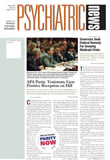Older Americans, and especially older white men, are at greater risk of suicide than any other group. And now some of the factors that increase seniors’ suicide risk have been identified in two studies reported in the August American Journal of Geriatric Psychiatry.
Those factors are depression, poor sleep quality, limited social support, and the possession of firearms.
In the first study, Carolyn Turvey, Ph.D., of the University of Iowa College of Medicine, and her colleagues followed some 15,000 elderly subjects’ mental and physical health over a decade as part of the Established Populations for Epidemiological Studies of the Elderly.
Of those subjects, 21 committed suicide during the study period. Baseline and follow-up data about these 21 subjects were then compared with baseline and follow-up data about the remaining subjects (controls) to identify suicide risk factors.
Depression, poor sleep quality, and absence of a relative or friend to confide in turned out to be risk factors, whereas medical illness and alcohol use were not.
Interestingly, depression, poor sleep quality, and limited social support have previously been identified as risk factors for death by natural causes, as well as for death by suicide. Or as Turvey and her team noted in their study report: “It appears that these variables erode a will to live that affects mortality even in the absence of suicidal tendencies.”
In the second study, Yeates Conwell, M.D., of the University of Rochester School of Medicine, and his colleagues probed the role of firearms in senior suicide risk, since firearms are the most common method of suicide used by both men and women in later life.
The subjects included 86 persons aged 50 or older who had committed suicide and 86 community control subjects individually matched on age, sex, race, and county of residence.
The presence of a firearm in the home was found to be associated with an increased risk of suicide, even after controlling for psychiatric illness. Elevated risk was accounted for by access to handguns rather than to long guns and was more pronounced in men than in women.
However, it is probably not the presence of a firearm in the home per se that constitutes a risk factor for senior suicides, but rather the recent purchase of a firearm, Conwell and his team contended. The reason, they explained in their study report, is that firearm suicide rates for the elderly have declined markedly in states that have instituted waiting periods or background checks, or both, for handgun purchases.
Yet just as depression, poor sleep quality, limited social support, and the recent purchase of a handgun may put seniors at risk of suicide, social support and religious beliefs may help protect them against it. The reason to believe that this is the case comes from a third study published in the August American Journal of Geriatric Psychiatry.
This study, headed by Joan Cook, Ph.D., of the University of Pennsylvania, focused on a senior group with a very low suicide risk—older African-American women. Indeed, compared with older white men, older African-American men, and older white women, senior African-American women have had the lowest suicide rate for decades.
Cook and her colleagues interviewed 835 elderly African Americans, 77 percent of whom were women, in urban public housing developments to find out how many were having suicidal thoughts. They found that only 27 (about 3 percent) were. They then compared characteristics of the suicide-contemplation subjects with the subjects not contemplating suicide and found that the former were more likely to be experiencing depression and anxiety and to have less life satisfaction, fewer social supports, and fewer religious beliefs. In fact, some 90 percent of control subjects reported that they obtained a great deal of support and comfort from religion.
The study reports “Risk Factors for Late-Life Suicide: A Prospective, Community-Based Study,” “Access to Firearms and Risk for Suicide in Middle-Aged and Older Adults,” and “Suicidality in Older Americans: Findings From the EPOCH Study” are posted on the Web at http://ajgp.psychiatryonline.org under the August issue. ▪
Am J Geriatr Psychiatry 2002 10 407
